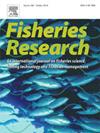多平台代谢组学方法研究急性热应激对新西兰黑足鲍鱼的影响
IF 2.3
2区 农林科学
Q2 FISHERIES
引用次数: 0
摘要
海洋温度的上升和海洋热浪事件的日益频繁对全世界的贝类渔业和海洋生态系统构成了重大威胁。在新西兰,由于这些极端的高温事件,天然鲍鱼(Haliotis iris)种群最近经历了死亡率上升,特别是在夏季。本研究采用多平台代谢组学和脂质组学方法,采用气相色谱-质谱(GC-MS)和液相色谱-质谱(LC-MS)方法,在对照实验室实验中研究了成年鲍鱼对3种温度处理(14、19和24°C) 24小时的代谢反应。在足部肌肉组织中,共鉴定出34种代谢物和34种脂质在温度处理中发生显著变化,与较低温度组相比,大多数在24°C时浓度更高。这些代谢变化表明由急性热应激引起的细胞和氧化损伤,以及代谢抑制、能量代谢、脂质代谢、渗透调节和膜组成和稳定性改变的证据。值得注意的是,天冬氨酸水平的下降以及三羧酸(TCA)循环中间体的变化表明,在热应激下,天冬氨酸-琥珀酸途径的激活是一种替代的能量产生机制。总的来说,这项研究为鲍鱼对海洋温度上升的代谢和脂质组反应提供了有价值的见解,增强了我们对海洋生物如何应对气候变化和极端热事件的理解。本文章由计算机程序翻译,如有差异,请以英文原文为准。
A multi-platform metabolomics approach to investigate the effects of acute thermal stress on New Zealand black-footed abalone (Haliotis iris)
The rise in ocean temperatures and the increasing frequency of marine heatwave events pose significant threats to shellfish fisheries and marine ecosystems worldwide. In New Zealand, natural abalone (Haliotis iris) populations have recently experienced elevated mortalities, particularly during summer months, due to these extreme thermal events. This study employed a multi-platform metabolomics and lipidomics approach using gas chromatography–mass spectrometry (GC–MS) and liquid chromatography–mass spectrometry (LC–MS) approach, to investigate the metabolic responses of adult abalone to three temperature treatments (14, 19 and 24 °C) over a 24-hour exposure period in a controlled laboratory experiment. A total of 34 metabolites and 34 lipids were identified in foot muscle tissue as significantly altered across temperature treatments, with the majority exhibiting higher concentrations at 24 °C compared to the lower temperature groups. These metabolic shifts indicate cellular and oxidative damage induced by acute thermal stress, along with evidence of metabolic depression, disruptions in energy metabolism, lipid metabolism, osmotic regulation, and alterations in membrane composition and stability. Notably, the decrease in aspartic acid levels, alongside changes in tricarboxylic acid (TCA) cycle intermediates, suggests the activation of the aspartate–succinate pathway as an alternative energy production mechanism under heat stress. Overall, this study provides valuable insights into the metabolic and lipidomic responses of abalone to rising ocean temperatures, enhancing our understanding of how marine organisms respond to climate change and extreme thermal events.
求助全文
通过发布文献求助,成功后即可免费获取论文全文。
去求助
来源期刊

Fisheries Research
农林科学-渔业
CiteScore
4.50
自引率
16.70%
发文量
294
审稿时长
15 weeks
期刊介绍:
This journal provides an international forum for the publication of papers in the areas of fisheries science, fishing technology, fisheries management and relevant socio-economics. The scope covers fisheries in salt, brackish and freshwater systems, and all aspects of associated ecology, environmental aspects of fisheries, and economics. Both theoretical and practical papers are acceptable, including laboratory and field experimental studies relevant to fisheries. Papers on the conservation of exploitable living resources are welcome. Review and Viewpoint articles are also published. As the specified areas inevitably impinge on and interrelate with each other, the approach of the journal is multidisciplinary, and authors are encouraged to emphasise the relevance of their own work to that of other disciplines. The journal is intended for fisheries scientists, biological oceanographers, gear technologists, economists, managers, administrators, policy makers and legislators.
 求助内容:
求助内容: 应助结果提醒方式:
应助结果提醒方式:


